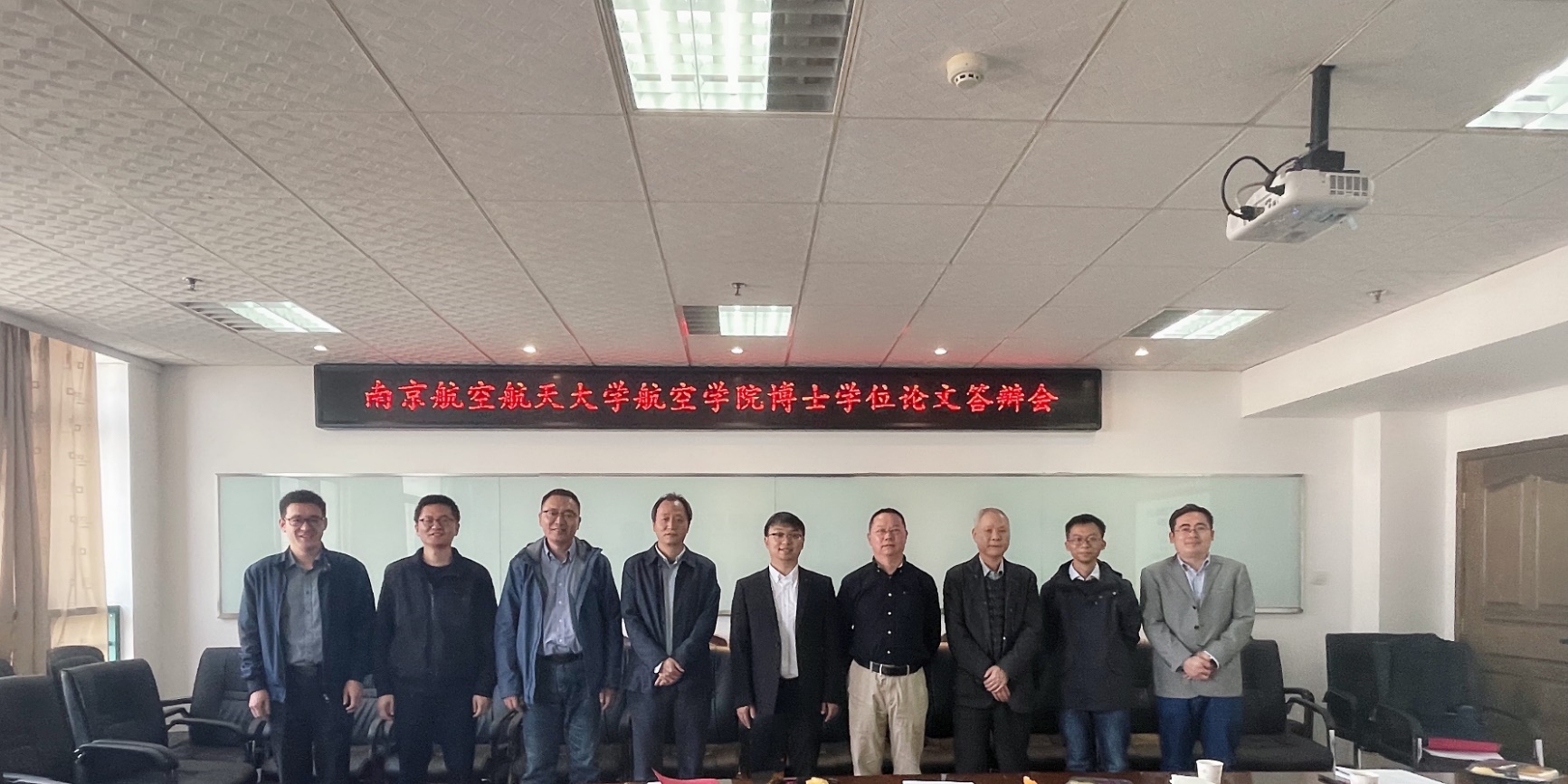2022年3月15日上午10时,团队博士研究生罗操群在南京航空航天大学明故宫校区航空学院705室进行学位论文答辩。答辩主席为南京理工大学理学院章定国教授,答辩委员有河海大学力学与材料学院茅晓晨教授、南京航空航天大学航空学院刘先斌教授、陈仁良教授、金栋平教授、文浩教授和陈提教授。答辩主持人为南京航空航天大学航空学院孙加亮讲师。
罗操群博士师从金栋平教授和文浩教授,主要研究方向为绳系卫星系统动力学与控制,博士论文题目为《刚柔耦合绳系卫星编队系统动力学与控制》。经过一个半小时的汇报和提问环节,罗操群博士获得了答辩委员会的一致认可,期间也对多个该领域前沿问题进行了热烈的讨论。最后,经过答辩委员会投票表决,一致通过罗操群同学的博士学位论文答辩,并建议授予工学博士学位。

摘要:
绳系卫星编队系统在对地观测、深空探测、空间站舱外服务、航天器对接引导以及空间目标捕获和拖离等航天任务中具有广阔应用前景。目前,绳系卫星编队飞行已成为突破空间探测器小孔径和低成像分辨率等限制的一项重要技术。由于绳系卫星编队系统的内在非线性、大柔性和小阻尼等特证,加上柔性系绳和卫星本体之间的耦合作用,导致系统呈现复杂的非线性动力学。
本文以深空探测为背景,针对绳系卫星编队系统的释放展开、状态保持和重定向等在轨任务,研究动力学建模、分析与控制问题。论文的主要内容如下:
(1)提出了面向控制器设计和动力学研究的刚柔耦合绳系卫星编队系统动力学建模策略。针对绳系卫星编队系统的控制器设计问题,提出了基于哑铃模型的近地轨道两体电动力和非电动力绳系卫星编队系统的建模方法,以及基于两段式哑铃模型的日地L2点附近开轴幅型三体绳系卫星编队系统的建模方法。针对绳系卫星编队系统动力学研究,提出了计入轨道运动的近地轨道刚-柔耦合两体绳系卫星编队系统的动力学建模方法;基于Hill限制性三体问题假设,提出了日地L2点附近刚柔耦合开轴幅型三体绳系卫星编队系统的建模方法。
(2)提出了两种基于能量原理的系绳电流开关控制律,实现了释放过程中系绳姿态的调整;考虑到系绳的非负张力约束,提出了一种解析的系绳拉力反馈控制律并用于辅助系绳的三维释放。通过参数化方法,研究了不同轨道倾角、不同精度的地磁场模型和不同控制方案对系统动力学行为的影响。
(3)针对非电动力两体绳系卫星编队系统动力学建模问题,计入地球扁率引起的J2摄动影响,建立了精确化的动力学模型。针对释放展开任务,提出了两段式的系绳弹射释放策略及一种综合控制方案。基于有限时域优化控制方法,将系绳释放展开问题转换为开环最优控制问题,利用Legendre-Gauss-Radau伪谱法进行离散求解;提出了一种闭环反馈轨迹跟踪控制律跟踪最优释放参考轨迹;基于四元数反馈的燃料最优控制方法,提出了一种卫星刚体姿态控制律。
(4)针对含时变长度柔性系绳的刚柔耦合三体绳系卫星编队系统,提出了一种高精度动力学建模方法。基于任意拉格朗日-欧拉(Arbitrary Lagrangian-Eulerian, ALE)描述的多体动力学框架,采用绝对节点坐标方法(Absolute Nodal Coordinate Formulation, ANCF)实现了时变长度柔性系绳的大位移和大变形描述,采用自然坐标方法(Natural Coordinate Formulation, NCF)实现了刚体卫星的整体运动描述。针对绳系卫星编队系统的自旋释放过程,提出了一种基于系绳释放速度控制和采用喷气力辅助的综合控制策略。采用参数化方法,对比研究了系统初始自旋角速度、喷气力和初始系绳释放长度对系统自旋释放动力学的影响。
(5)针对日地点附近Halo轨道的旋转绳系卫星编队系统,提出了一种适用于N体任意构型柔性绳系卫星编队系统的动力学建模方法。基于热辐射理论,在动力学模型中计入空间热效应的影响,提高了动力学建模精度。针对含不确定性参数的绳系卫星编队系统在状态保持阶段的动力学问题,提出了动力学响应问题的区间描述方法,建立了区间参数不确定系统的边界估计模型;基于高近似精度的Chebyshev区间算法,提出了面向绳系卫星编队系统的不确定性动力学分析方法。通过对比研究,分析了子卫星质量、系绳初始温度和系绳阻尼不确定性参数对系统动力学的影响。
(6)针对日地点刚柔耦合绳系卫星编队系统的三维重定向问题,提出了一种复合控制方案。考虑非线性动力学和复杂约束条件,提出了一种非线性模型预测控制器,用于获得系统的期望姿态。通过数值离散和非线性规划方法滚动求解开环最优控制问题,得到了系统重定向状态输出和控制输入的最优参考轨迹。为减小模型差异对控制效果产生的不利影响,提出了一种自适应增益反馈控制器跟踪参考轨迹。数值仿真验证了控制方案的有效性和可行性。
Abstract:
Tethered satellite formation (TSF) system has promising applications in space missions such as earth observation, deep space exploration, space station extravehivular service, spacecraft docking and guidance, space target capture and deorbiting. In recent years, the TSF flying has become an important technology for breaking through the limitations of small aperture and low imaging resolution of space detectors. Due to the inherent nonlinerity, the large flexibility, and the small damping, it is easy to yield the complected nonliner dynamics in a TFS such as rope skiping, especially when the flexible tethers and the satellite bodies are coupled.
This thesis focuses on the dynamics and control problems of TFS during tether deployment, station keeping and retargeting for a deep space exploration. The main work and contributions of the thesis are follows:
A fundamental dynamic modeling strategy is proposed for the controller design and detailed dynamics study of rigid-flexible coupling TSF systems. Focusing on the controller design, dynamic modeling methods based on one-piece dumbbell model assumption are proposed for the low-earth-orbit two-body electrodynamic and non-electrodynamic TSF systems; dynamic modeling methods based on two-piece dumbbell model assumption are proposed for the hub-and-spoke three-body TSF systems near the sun-earth second libration point. Focusing on the further dynamics analysis, dynamic modeling methods for the low-earth-orbit rigid-flexible coupling two-body TSF systems are proposed by incoporating orbital motion and coupling effects between flexible tethers and rigid satellites; dynamic modeling methods for the rigid-flexible coupling three-body TSF systems near the sun-earth second libration point are proposed based on the Hill’s approximation for the restricted problem of three bodies.
Focusing on the three-dimensional deployment problem of a bare electrodynamic tether in a two-body TSF system, two current switch on/off controllers obeying two different criterions related to the power of Lorenz force are proposed to stabilize the libration motions of the deployed tether. Accounting for the constraint of non-negative tether tension, an analytical feedback control law using a saturation function is proposed to assist the three-dimensional deployment. Moreover, comparisons of three groups of numerical simulations are performed to evaluate the influences of orbital inclinations and geomagnetic field models and the performance of the active control laws on the dynamics of the system.
Focusing on the dynamic modeling for a two-body non-electrodynamic TSF system, the J2 perturbations due to the oblateness of the earth are involved into the modeling to improve the accuracy of the dynamic model. For the three-dimensional deployment of the system, a two-stage deployment strategy and a hybrid control strategy for stabilizing attitude motions of tether and satellites are proposed. Based on a finite-time optimal control method, the problem concerning tether deployment is converted into an open-loop optimal control problem, which is then solved by a Legendre-Gauss-Radau pseudospectral method. A closed-loop feedback controller is developed to achieve the deployment by tracking an open-loop optimal trajectory of tether libration states and control input. Based on an optimal fuel control method using feedback of attitude quaternions, an attitude control law for stabilizing the satellites’ attitude motions is proposed.
For the dynamic analysis of a three-body TSF system containing a flexible tether with a time-varying length, a novel modeling strategy with high accuracy is proposed based on flexible multi-body formulation methods. Both of the large displacement and large deformation of the variable-length tethers are described by utilizing the Absolute Nodal Coordinate Formulation method in a framework of Arbitrary Lagrangian-Eulerian description. The Natural Coordinate Formulation method is used for describing the overall rigid motions of the three satellites. The tether deployment is achieved by regulating deployed velocity and applied jet forces. Parametric methods are used to investigate the influences of system parameters including initial spinning velocity, applied jet force and initial deployed tether length on the deployment dynamics of the tethered system by comparisons.
A new dynamic model, which could also be applied to any N-body multi-tethered satellite system of arbitrary configurations, is proposed for a spinning flexible TSF system on a Halo orbit around the sun-earth L2 libration point. Based on theory of thermal radiation, the space perturbation of thermal effect is incorporated into the dynamic model to improve accuracy. Interval descriptions are presented to formulate the problem of solving dynamic responses of a tethered formation system with uncertain interval parameters in station keeping phase as a bounds estimation problem. An interval method with high efficiency, utilizing the Chebyshev series for approximation, is presented to solve this problem by only using the lower and upper bounds of the uncertain parameters and avoiding a global search in numerical results. The mass of the sub-satellites, the initial temperature and the damping of the tethers are selected as uncertain parameters for investigating their influences on the dynamics of the system.
A compound controller is proposed for three-dimensional retargeting maneuver of a rigid-flexible coupling multi-tethered satellite formation at the sun-earth L2 libration point. Accounting for the inherent nonlinear dynamics and complicated constraints, a nonlinear model-predictive control law for the retargeting problem of concern is developed to achieve the desired attitude of the system. Numerial discretization and nolinear programming methods are used to repeatly solve the optimal control problems and to obtain the optimal reference trajectory of tether libration states and control input. To eliminate the influences on control effects due to the errors between the dynamic models, an adaptive gain control law for tracking the optimal reference trajectory is proposed. Comparative simulation cases are presented to validate the proposed compound controller.
博士期间发表论文:
Caoqun Luo, Hao Wen, Dongping Jin. Deployment of flexible space tether system with satellite attitude stabilization, Acta Astronautica. 2019, 160: 240-250.
Caoqun Luo, Jialiang Sun, Hao Wen, Dongping Jin. Dynamics of a tethered satellite formation for space exploration modeled via ANCF, Acta Astronautica. 2020, 177: 882-890
Caoqun Luo, Hao Wen, Dongping Jin, Shidong Xu. Dynamics of a flexible multi-tethered satellite formation in a Halo orbit with uncertain parameters, Communications in Nonlinear Science and Numerical Simulation. 2021, 99: 105828.
Caoqun Luo, Lei Huang, Hao Wen, Junjie Kang, Dongping Jin. Model predictive control for spin-up maneuver of an EDT system, Acta Astronautica. 2021, 189: 55-62
Caoqun Luo, Hao Wen, Dongping Jin, Jialiang Sun. Retargeting control of a multi-tethered satellite formation at sun-earth libration point, Advances in Space Research, 2022, in press.
Caoqun Luo, Hao Wen, Dongping Jin, Shidong Xu. Long-term deorbiting control of an electrodynamic tether system using periodic solutions, Acta Astronautica, under review.
Caoqun Luo, Hao Wen, Dongping Jin. Libration control of bare electrodynamic tether for three–dimensional deployment, Astrodynamics. 2018, 2(3): 187-199.
罗操群, 孙加亮, 文浩, 胡海岩, 金栋平. 多刚体系统分离策略及释放动力学研究. 力学学报, 2020, 52(2): 503-513.
张恒,文浩,罗操群. 旋转电动帆推进性能指标分析. 动力学与控制学报,2019, 17(3): 281-287.
罗操群,文浩,金栋平. 柔性绳系卫星编队系统释放动力学研究. 第十二届多体动力学与控制暨第七届航天动力学与控制和第十五届全国分析力学联合学术会议,沈阳,2021.
毕业博士简介:
罗操群,男,1993年7月生于江苏省扬州市。2011年9月考入南京航空航天大学飞行器设计与工程专业,2015年6月毕业并获得学士学位。2015年9月起,进入该校力学专业攻读硕士学位,并于2017年4月开始攻读博士学位,从事动力学与控制研究,导师金栋平教授和文浩教授。





